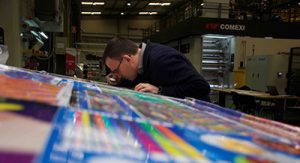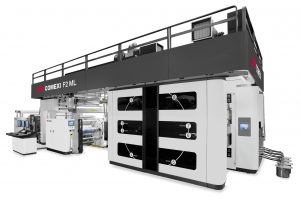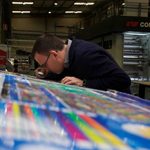Flexographic print is an established print process, but the rapidly changing global print marketplace is challenging the print suppliers to implement advances in flexographic technology to improve efficiency. A Packaging MEA report

The main factors that cause the converters to print slower than their presses are supposedly capable of, and that prevent them from getting repeated performance within a succession of jobs are mainly: vibration or bouncing at high speeds, difficulties in achieving a consistent quality through the full length of the job, and the lack of skilled printers, which leads to an increase of the start-up waste and increased time needed for colour management.
The flexo process
Vibration is inherent to the flexo process. As far as the plates have printing/non printing areas, there will be impacts coming from the plate at every turn. But not only the vibrations come from the plate, when printing at high speeds, any variations in accuracy or out-of-balance of rotating parts, are magnified and can lead also to vibrations. All vibrations negatively affect the print quality and consistency, and indirectly affect the above parameters too. Optimising the performance of the flexo process, such as ink transfer and printing pressure, and eliminating variables that may cause bouncing is the target for all flexo manufacturers. The main goal is to achieve consistent printing quality at high speeds.
Controlling the variables of the flexo process helps to eliminate defects during printing, but as some of the vibrations are inherent to the flexo process, a robust manufacturing of the press is the most important key to the printing quality and repeated performance.
Press requirements
Starting with the foundations of the machines, the frames of the presses need to be designed to minimise vibrations, with maximum possible solid areas and minimum partitions.
The carbon fibre mandrels provide better impact absorption and better behaviour against bouncing at high speeds. The bigger diameter of the anilox and plate mandrels results in a lower flexion level when printing at high speeds. The tests prove both a recovery time against impacts and a flexion level 50% lower than a conventional steel mandrel.
The consumables
One of the key factors to ensure consistent quality through dot gain control is the stability and consistency of the ink doctoring in the anilox. Ink must be delivered constantly during all the job and in the correct quantity to achieve the best printing quality. One very important point on the doctoring is the robustness of the doctor blade and its supports, and the adjustment of it against the anilox. The use of low friction pistons guarantees the minimum pressure applied from the blade to the anilox, thus leading to a better performance in regard of bouncing and vibrations, less wear of the blades because of the synchronised movement of the doctor blade with the anilox mandrel, and also eliminating the ink leakages.
Automating press and register
First example of innovation in the field of automation is the Cingular Real, which enables the set up of pressure and register with only one click, ensuring accuracy and precision by finding the exact point for optimal printing quality with minimum overpressure. The name stands for a real adjusting system, because when it finishes the adjust, it has already been able to see the real result, so the waste generated is the real waste, no further corrections need to be made by the machine or the operator. Second example of automation is the colour matching system, which objective is to minimise the waste of material, ink and time during colour matching. Colour adjustment is still often done directly on the machine during the job changeover, introducing a lot of variation in the time and waste required for doing the whole changeover, negatively affecting the overall performance of the machine. By using these systems, colour adjustment becomes a simple task that requires almost no knowledge.
Job set up can (and should) also be reduced by thinking outside the box and changing conventional procedures to new ones. It is mandatory to invest, not only in new products, but also in knowledge to know
why and how the companies can be more efficient and productive in its industrial processes and be able to offer better solutions and better-quality products to their customers.

In this sense, the extended gamut printing is a system that most of the flexible packaging companies have heard about, but maybe they do not know how to implement it into their business.
Extended gamut printing
There are several reasons for considering expanded gamut printing, but most of them fall into two categories: financial and quality. How could you print higher quality packagi
ng being more profitable and how could you become more efficient and productive with the expanded gamut printing system?
Ink savings, reduced wash-ups, combo-printing and material savings are part of the huge list of advantages that a converter can enable by switching to this process. The question then is: Can any machine print with expanded gamut? And the answer is, Yes.
Recent advancements
In the recent years, a number of combined technological advances have mixed to contribute to overcoming the previous limitations in flexographic printing: printing presses and anilox engraving technologies, ink metering and formulations, process control features and, most notably, advances in prepress and plate technologies have resulted in increasing the ease and the quality of the result. When printing with expanded gamut printing presses can generate relevant and valuable production management data in real time.
This goes from production speeds, output, productivity, set-up times, number of reels or downtimes for preventive maintenance and repairs. Monitoring and analysing of this data is the first step in the long but quick-evolving motorway towards soft machine intelligence and autonomy.
Through machine learning algorithms, machines can recommend or suggest an initial configuration (tensions, temperatures, viscosities, volume of the anilox, colour separation, speed, etc) to the operator in order to reduce their necessary expertise and maximise machine efficiency: less waste, more uptime and more speed.
In the continuous research for systems that reduce the learning curve for a new printing machine, the process has led flexography to meet machine learning and this, together with the industry 4.0, leads to the digitalisation of the process.
We cannot know what will the future of printing be, but if we continue following market trends and investing in innovative solutions that boost our presses competitivity, the future will still look very promising for flexo printing in flexible packaging!



